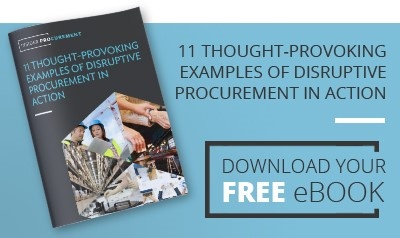If you think that your chocolate bar is smaller than when you were a kid then you are probably right. In November 2016, Mondelez the makers of Toblerone increased the spacing between the famous triangular chunks in order to reduce the weight by 10%, and at the same time Mars made a whopping 15% reduction in Maltesers. That’s considerably fewer round balls of chocolatey joy in each pack!

Then, in September 2017, there was a twitter storm when McVities reduced the size of packs of Jaffa Cakes from 12 to 10.
And it’s not just chocolate that is affected.
Over the last 5 years the Office for National Statistics reported that the size of product has shrunk for 2,529 consumer items from toilet roll to coffee but most (aside from Jaffa Cakes, I should mention) are still being sold for the same price.

Corporate Shrinkflation & Traditional Procurement
The bad news is that this phenomenon is not confined to consumer goods. It is rife in B2B trading as suppliers look to recover more contribution from each unit sold.
Nor is "shrinkflation unique to goods. Services are just as vulnerable to this sort of selling strategy - even more so in some cases as there the ‘thing’ being purchased is less well defined.
In the traditional world of procurement, where the function is focused on supplier margin reduction and price savings, this causes major issues as the business effectively gets less for its money over time. This leads to a subsequent erosion of savings claimed by procurement and a resultant loss of confidence in the efficacy of the function by key stakeholders.
Spotting Supplier Shrinkflation Strategies
The good news is that with some simple tools and processes shrinkflation is easy to spot in most instances, and the actions to arrest it are usually straight forward.
Let’s have a look at 4 fairly common supplier shrinkflation strategies and some immediate actions to take to reduce the risk;
1. Testing Tolerance
The is the simplest of them all and therefore one we see regularly. In testing tolerance suppliers over time reduce the specification of the product or service being supplied and wait to see if the buyer notices. The chocolate bar is a good example of this, as is reducing the grammage of the paper in packaging or in services working a 7.5 hour day (don’t forget lunch!) when the deal was based on 8 hours.
Reduce the Risk: through good record keeping and ensuring that the basis of the price agreement is crystal clear and in writing. If it is practical and appropriate store gold seal samples for future reference.
2. Re-Basing
This approach focuses on changing the reference point for the price agreement and shrinking it again delivering less for the same money.
We saw a recent example in one of our clients where the original price agreement was based on, for the purposes of this illustration, a 100 gram product with a 10% tolerance. In the process of updating the agreement, which suited both sides, a new sample was provided which was "on spec" (within the tolerance) at 90 grams, but the supplier then made this the new standard to which a 10% applied.
This would have meant that an 81 gram product under the new agreement, would have been considered on spec. But for some quick-witted procurement person, the company would have agreed to a near 20% reduction in the weight of the product against which the price was agreed.
Reduce the Risk: Again, good record keeping is key to stopping this value erosion, as is clearly recording and reviewing the specification to be used when agreeing commercials.
3. De-list/Re-list
This is a favourite of suppliers in sectors like spare parts of consumables, who have long product lists with an inevitable churn of items. Here the supplier periodically retires target products and then re-introduces them at a higher price on a different product code. The sheer number of items means many buyers do not regularly handle the parts, don’t spot it happening and the supplier grows their margin through the back door.
Reduce the Risk: Careful and systematic analysis of product changes is essential. Look for trends and review the proposed changes in detail including physical products if you can. It may seem like admin, but neglect it at your peril.
4. Reversing Moore’s Law
Those of you familiar with Moores law (and those of you who have ever bought a laptop) will be aware of the concept that, every 2 years computing capacity doubles for roughly the same cost. Whilst there is now some evidence to suggest this is changing, suppliers in the technology space still use this to their advantage. Here’s how:
The buyer wants to buy top of the range laptops for her business and is quoted £2,000 by the supplier for the FX2000. She also wants consistency across the estate from a maintenance perspective so agrees a 3 year deal and plans to replace the current fleet of RG1000’s with the FX2000 as new starters join or old units fail. The catch is though that after just 3 months the FX2000 is no longer top of the range and is now being sold at £1,750 and by year 3 a new unit would be worth just £800. But she’s still paying £2,000… hardly the same value as day 1.
Reduce the Risk: Research thoroughly how prices change over time in that market. Take time to fully understand where the product you are buying sits in the lifecycle of the supplier's range. "Benchmark clauses" in agreements can be life savers, so aim for an annual review to discuss your agreed benchmarks - especially for technology-led categories.
Why do Suppliers Pursue Shrinkflation Strategies?
All businesses (with very few exceptions) are in business to make money. The pressure to grow profits is palpable so inevitably this means that suppliers look for new ways to make money from their customers. To do this they have 3 levers to pull:
- Increase price
- Increase volume
- Reduce costs.
A shrinkflation programme can deliver on all 3 of these and can either be a conscious decision or the organic results of the incentives in the system. In other words, some suppliers set out very deliberately to give you less value over time – others get there almost by accident.
Knowing this, it is tempting to think that most suppliers are mercenary organisations, hell bent on extracting cash from you the customer. Thankfully, this is rare, for 3 main reasons:
- Purposeful shrinkflation jars with the values of the suppliers' staff (not many people are OK with giving less value to their customers)
- The majority of heads of business get that short term, underhand tactics are risky in the mid/long term
- Very few suppliers have enough control over their organisations (people, processes, systems) to execute a systematic shrinkflation strategy.
In the vast majority of cases when you see shrinkflation in your trading relationship, it is probably the result of individuals from the supplier trying to deliver on their own objectives but feeling unable to address their issues directly with you the customer.
As a result, they revert to a series of small decisions which over time culminate in you getting less for your money.
In this way, the majority of corporate shrinkflation occurrences should really be viewed as symptoms of a relationship which isn’t as open and productive as it should be.
How to Turn the Tables
Disruptive procurement has the power not just to stop shrinkflation, but also to use it as an opportunity to increase value from the supplier. In our post on the subject, we said that disruptive procurement is the process of creating real business value and competitive advantage by:
- deconstructing what the business really needs,
- challenging established business processes,
- leveraging knowledge from outside the normal points of reference, and
- designing, assembling and managing the supply chain in new and innovative ways..
Dealt with appropriately - using disruptive procurement thinking - a shrinkflation event becomes less of a risk and more of an opportunity.
Use the "Why, Why, Why" technique to find out exactly why the supplier has been driven to reduce value.Let's look at some examples:
Is it because we are an expensive account to service?
We may well find that if, say the supplier, is reducing the value because we are an expensive account to service then by changing what we are asking for could be a win-win.
Are the contract terms not working for the supplier?
The supplier may feel unable to communicate that the current terms are not working for them. This is an early intervention opportunity for procurement to do something about it before the downward spiral of reduced service and arguments over price set in. A costly event for everyone concerned and very often entirely avoidable.
Is it that one of their components has increased in price?
Understanding this problem could lead to you, the customer, redesigning your requirement to make use of cheaper alternatives - another win-win situation for you and the supplier.
And more....
It's easy to see that by delving into the detail and finding the real reason why suppliers are changing the value they deliver can actually result in benefits on both sides. This is just one of the 7 principles of disruptive procurement.
To learn about some real life examples of disruptive procurement in action, download our eBook and learn from your peers in hospitality, retail, care homes and more...

